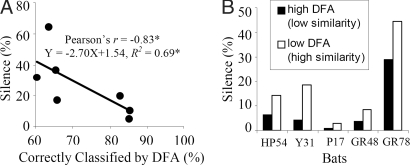Fig. 4.
The correlation between sonar signal DFA and silent behavior. (A) Each data point represents a pair of bats and a total of 7 pairs of bats were used in this study. Five call features (start/end frequency, duration, bandwidth, sweep rate) were used in discriminant function analysis (DFA) to classify calls from different individuals. The percentage correctly classified represents how well these 5 features could distinguish an individual's echolocation calls. The more separation in the time-frequency structures of a bat pair, the less silent behavior they showed in this study. * indicates p < 0.05. (B) An individual bat's silent behavior depended upon the similarity of its calls to that of the bat with which it was paired. Data shown for the 5 bats that were paired with more than 1 individual. Black bars represent the percentage silence of a bat when paired with another bat whose signals show a high DFA. White bars represent the percentage silence of a bat when paired with another bat whose signals show a low DFA. High DFA indicates low similarity between paired bats in call design, while low DFA indicates high similarity. All bats tested in multiple pairings showed an increase in silent behavior when paired with an individual whose signals were more similar to its own.

